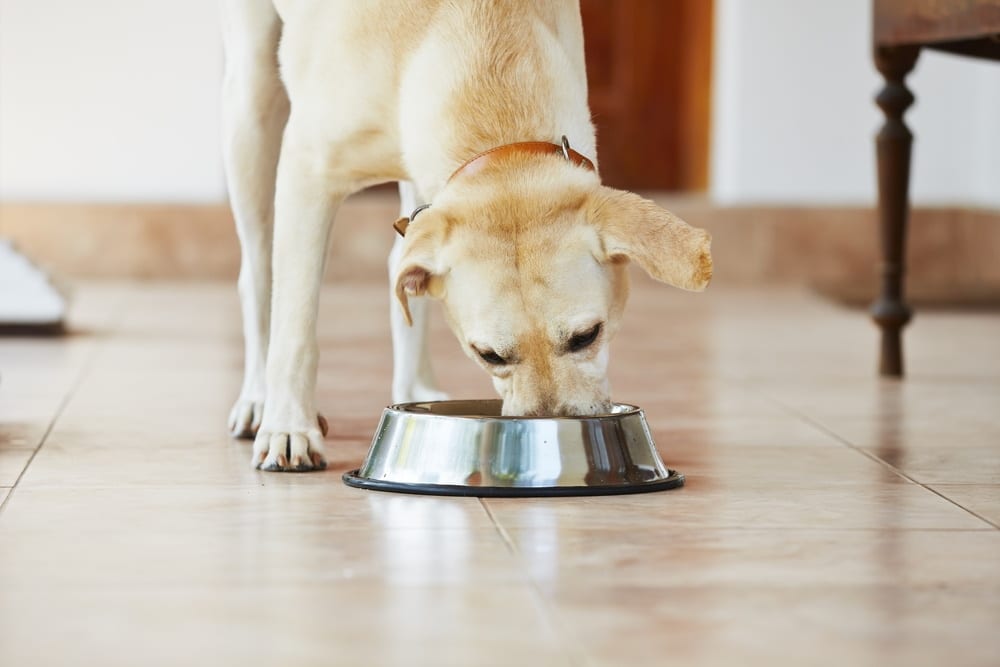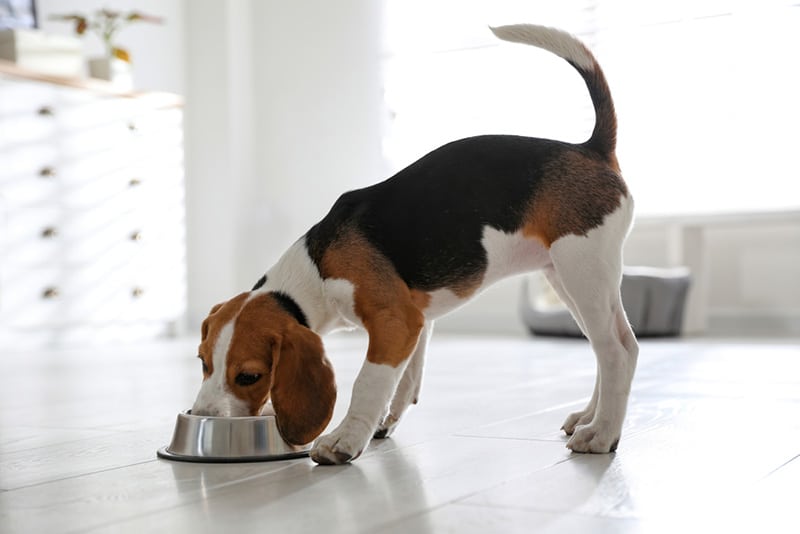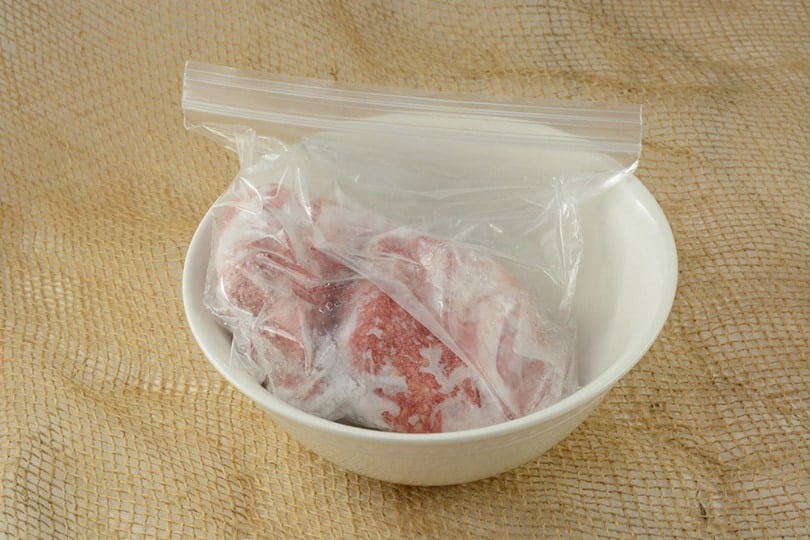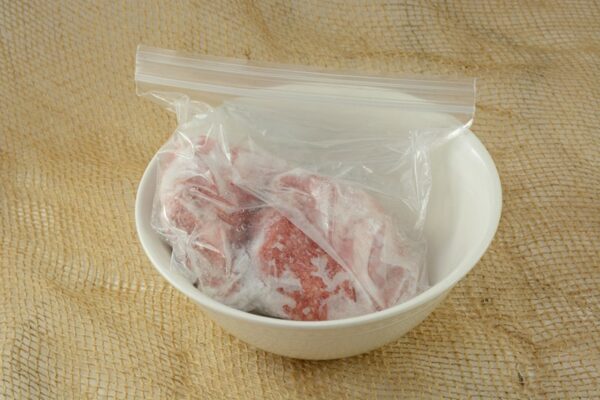Feeding five hungry hounds with very different dietary demands has helped me to appreciate all the forms that dog food comes in: kibble, canned, just-add-water, cooked in small batches and frozen, freeze-dried, and frozen raw. Some are no-brainers. But feeding frozen meat can be complicated, as it requires preparation, premeditation, and safe handling. However, seeing the dramatic difference dining on frozen-then-thawed real meat has made in the overall health of my German Shepherd, Desiree, and being a serious health nut where my dogs are concerned, I’m committed to providing it for her. I hope you’ll find my obsessively detailed tips helpful (you would think I’m a Virgo or something).

The 5 Tips for Serving Frozen Dog Food
1. Keep it Frozen
When you purchase frozen dog food, it needs to stay frozen on the trip home. Whether it’s cooked or raw, you don’t want the meat to become partially thawed, because you cannot refreeze it — you’ll have to put the whole package in the fridge to thaw at once. Coordinate dog food pickups when you can travel with an insulated picnic hamper or bag, plus a couple of freezer packs. (Obviously, this is especially important in warm weather.) If you don’t have a car, the freezer packs plus the frozen food equals a heavy load. If you’re shopping solo and traveling on foot or by public transportation, don’t plan on carrying much else (unless it’s an ultra-lightweight bag of freeze-dried food; more about that in a bit).
2. Thaw in the Fridge
Once your haul is safely stowed in your freezer, you’ll need to thaw out a portion for the next feeding. Always thaw in the fridge. I budget 12 hours or overnight, and I’ve dedicated a Tupperware container to thawing out Desiree’s raw food. I’m no fan of plastic food-storage containers — I much prefer glass ones with plastic lids, but I’ve found that glass slows down the process significantly, so I’m met with semifreddo meat popsicles at feeding time. Still-frozen meat is tough on digestion, so plastic fridge storage is the way to go in this case.

3. Keep Things Safe
Frozen raw food comes in two serving styles: patties (about the size of a big burger) and medallions, which resemble meatballs or sliders. Both thaw at the same rate. Just to be sure I’m covered, I place a double serving in the fridge (two patties) each time. I have a dollhouse-size kitchen, so I’m very mindful of safe food-handling practices. I wash the empty Tupperware with hot soapy water before reloading it, and decontaminate my mitts with soap and hand sanitizer.
4. Have a Backup
So, what happens if, say, you forgot to transfer a portion or two from freezer to fridge and your dog’s food is still frozen (or semi-frozen), and she’s looking at you expectantly with an expression that quite clearly says, “Where’s breakfast?” For these occasions, it’s good to keep a supply of freeze-dried food in the same protein flavor your dog prefers. Patties are lightweight and portable (see above), and they’re shelf-stable, so there’s no need to worry about refrigeration. (Safe food handling is still important, though.)
Desiree eats beef exclusively, so I buy freeze-dried beef patties as backup. This way, I know my girl won’t go hungry, and she won’t have an allergic reaction to the change in food, because it’s the same food, just preserved differently. One time, the store was out of plain beef flavor, so I took a gamble on Stella & Chewy’s Surf ‘N Turf, a beef-salmon combo, which happily agreed with Desiree’s famously sensitive GI tract.
5. Have an Alternative
If the cupboard is bare and I’m all out of freeze-dried patties, I march out to the supermarket for a small, lean, boneless steak (shoulder or sirloin) for Desiree, whose inner carnivore is thrilled to encounter soft, bloody meat. Remember, unless you’re shopping at Whole Foods, most supermarket meat is full of steroids, so I don’t like to do this too often. And whenever I do, I make sure to pop a milk thistle capsule into Desiree’s next meal to protect her liver from the hormones in the meat.
I know this is a lot to remember. Two pet-food producers feel your pain, however, and offer new products that focus on convenience. My Perfect Pet makes dog food from “restaurant-quality meats,” cooking them with veggies and other ingredients to be nutritionally balanced and easily digested, then freezing the recipe into rectangular bars that resemble appetizing slices of Mom-made meat loaf. The main ingredient of Knight’s Blend flavor, named for the company mascot Ninja-Knight, is beef round. It was happily devoured by Desiree, and close inspection of her poops for the ensuing few days confirmed that it also got along famously with her digestive system.

Meanwhile, Nature’s Variety, makers of Instinct Raw frozen food, will introduce frozen raw food in small, kibble-like pellets in July. Instinct Raw Bites promises to thaw out in minutes as opposed to hours. For pets accustomed to eating kibble — like the rest of my canine crew — there’s also Instinct Raw Boost, a grain-free dry food combined with bits of freeze-dried meat, so even dry-dog-food diners can enjoy a high-protein diet. And that’s the whole point of frozen dog diets, says Dr. Ohad Barnea of New Jersey’s Tenafly and Cliffside Animal Hospitals.
“Whether or not you make the decision to feed your cat or dog raw food, ensure that what you are feeding is minimally processed,” he says. “The less processed your pet’s food is, the easier it will be for them to digest. Remember, to maximize your pet’s health, keep the diet as close to natural as possible. I have recommended feeding Instinct frozen raw products for more than seven years, and I can attest to the fact that cats and dogs who are fed raw diets suffer far less from medical problems. They are simply healthier. Benefits I’ve seen include allergy relief, weight management, improved skin and coat, and smaller stools.”
If, like me, you’re invested in the maximum possible longevity for your pets, experts agree that a minimally processed meaty diet keeps dogs looking and feeling younger, longer. “Feeding pets meals made up of real ingredients is cost-effective health-wise, and extremely worth it in the long run,” says pet nutritionist Celia Kutcher. “It improves all-over health, from teeth to digestion, just like it does with us. A majority of dry-food-only pets I see start going gray and getting a little rickety around 6 years of age — that’s not right. There are real, whole pet foods on the market — I’m a big fan of Sojos — but nothing beats fresh, minimally processed foods for all of us, including pets.”
I would love to hear about your experiences feeding your dog frozen food — cooked or raw. Please share in the comments!
Featured Image Credit: Merrimon Crawford, Shutterstock











